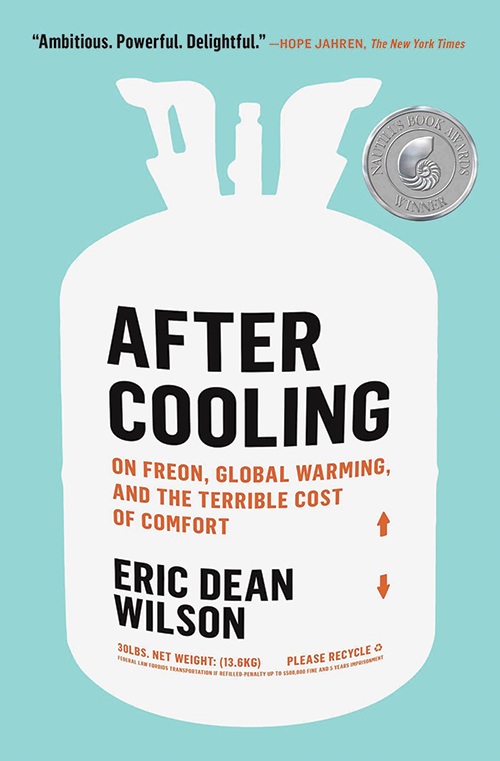
After Cooling: On Freon, Global Warming, and the Terrible Cost of Comfort
Reviewed by Pamela Haines
November 1, 2022
By Eric Dean Wilson. Simon & Schuster, 2022. 480 pages. $19.99/paperback; $14.99/eBook.
It was a hot summer in Philadelphia, Pa. As I closed windows and shades to the blazing sun, opened them to night breezes, took full advantage of cross ventilation and window fans, spent more time downstairs under a strong ceiling fan, and occasionally turned on our one window air conditioner, I read After Cooling.
The scope of this book is ambitious and multilayered. Many of the author’s goals involve relaying information: Give the history—and chemistry—of refrigeration, and tell the story of Freon, including a blow-by-blow account of the discovery of its role in creating the ozone hole and what has happened since. Describe the growth of air conditioning over the decades, the replacements for Freon for cooling, and their global warming impacts. But the heart of the book, weaving through all the data, is an ongoing meditation on comfort in the industrialized West.
There’s a lot to learn. Just 15 years after Freon was identified as the cause of the ozone hole, the world came together to address that terrifying global threat in the Montreal Protocol, signed in 1987. Yet one global crisis had been averted in the same moment that another rose to take its place, and the much larger and more slowly moving climate crisis has been harder to narrate and respond to than the compelling story of the ozone hole. Twenty years after its signing, a study found that the Montreal Protocol, continuously revised in the face of new scientific data, was actually reducing global warming emissions by five to six times what the Kyoto Protocol pledged.
While the chemicals that replaced Freon don’t damage the ozone layer, these hydrofluorocarbons (HFCs) have up to 1,300 times the warming potential of carbon dioxide—and our cooling habits continue to grow. Even in small numbers, their unchecked growth could account for 20 percent of global warming by the end of the century. New U.S. laws aim to phase down production of HFCs by 85 percent in the next 15 years, and the new class of refrigerants, HFOs, seem to be a big improvement. But the lesson from history is clear: beware the technological fix.
The harder challenge is to fix our habits: our assumptions about what we deserve; the White, middle-class American view of personal comfort as a commodity, energy-intensive, and material, embedded in values of individualism, social status, and personal safety; our goal of carefully curated and sealed environments; our view of discomfort as a danger. These habits are reinforced by our infrastructure, values, economic system, and forms of governance that continue the manufacturing of comfort on the one hand and vulnerability on the other.
We like our story of freedom and independence, our belief in our country’s invincibility and power to master anything, including the weather. But by sharing the planet’s active weather shell, we are connected to people and places we’ll probably never know. Acknowledging our shared vulnerability, the author suggests, might be the most critical and hardest part of implementing climate solutions.
The impacts of racism thread through the book: the slow attritional violence of the status quo; the South African farmers noting that “[t]he white man stole the weather”; air conditioning as a tool of eugenics, quietly weeding out the weak; the Pfizer vaccine’s need for ultra-cold freezers making it available only to those with means. Robin DiAngelo’s discussion of White people’s demand for racial comfort assumes additional meaning.
Though cooling is crucial for our survival, individual AC units can’t be the way. We need locally owned and controlled renewable energy supplies and a reinvigoration of public space. Tellingly, twice as many people died in Chicago in a mid-’90s heat wave than in a comparable one in the ’50s when no one had home air conditioning. The critical difference: fewer people were isolated in closed individual spaces back then. Everyone was out on the streets and fire escapes together, seeking out coolness with each other.
The point, concludes Eric Dean Wilson, is not to eradicate comfort but to overthrow and transform our definition of it, to question our threshold of discomfort, and to confront the fact that our comfort is currently contingent on the discomfort of others. After Cooling invites us to think more expansively about what we desire.
Pamela Haines is a member of Central Philadelphia (Pa.) Meeting. She is the author of Money and Soul, an expansion of a Pendle Hill pamphlet by the same name. Her newest titles are That Clear and Certain Sound and a second volume of poetry, Encounters with the Sacred and the Profane.



Comments on Friendsjournal.org may be used in the Forum of the print magazine and may be edited for length and clarity.